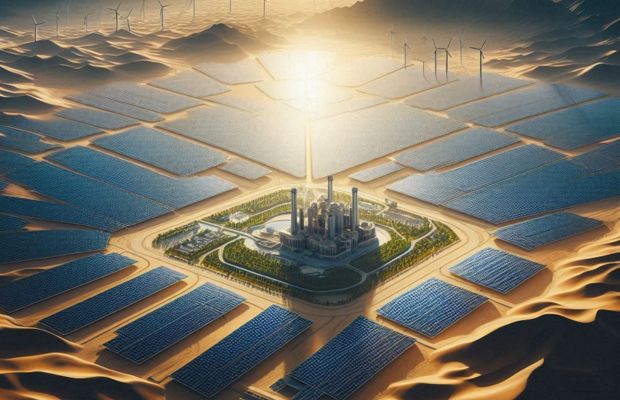- While still only partially operational, the Mohammed Bin Rashid Al Maktoum Solar Park, UAE, is the largest solar park in the middle east and one of the largest in the world
The Middle East region is making strides in renewable energy growth as global development increasingly moves away from conventional sources of energy. Renewable energy sources, such as solar, wind, and green hydrogen, have become the new engines powering growth and development. Some of the major oil-producing countries, like the UAE and Saudi Arabia, are now leading renewable energy growth in the region, with some of the largest solar projects powering the sustainable growth.
Here is a list of the top 5 largest solar power projects in the Middle East that are in partial or full operation today.
#1 Mohammed Bin Rashid Al Maktoum Solar Park, UAE
Full Capacity: 5 GW
The Mohammed Bin Rashid Al Maktoum Solar Park, an expansive and continuously growing solar project, is among the largest single-site solar installations globally. While it is projected to reach its full capacity of 5 GW by the end of this decade, the current operational capacity of over 2.6 GW already positions it as one of the largest solar projects in the Middle East, and the world, with total investments amounting to AED 50 billion.
The solar park uses a range of solar photovoltaic (PV) and concentrated solar power (CSP) technologies. In addition, it also hosts an Innovation Center. The project is home to one of the largest Research & Development centers in the region and includes PV solar and CSP testing facilities and a solar-powered water desalination plant. DEWA is developing the Maktoum solar park in phases.
Once completed in 2030, the park is expected to reduce carbon emissions by more than 6.5 million tons each year. Additionally, it features the world’s tallest solar tower, standing at an impressive height of 260 meters.
#2 Shuaibah Two Solar Facility, Saudi Arabia
Full Capacity: 2.6 GW
The Shuaibah 1 and Shuaibah 2 plants are situated about 80 km south of Jeddah in the Makkah region of Saudi Arabia. With a combined capacity exceeding 2,600 MW, these plants will harness solar energy and integrate into Saudi Arabia’s national grid once fully operational. The 600-MW Al Shuaibah 1 plant began commercial operations earlier this month, while the Al Shuaibah 2 will have a capacity of 2,060 MW.
According to ACWA Power’s third-quarter report, the total investment for the two projects is SAR 8.25 billion (USD 2.2 billion / EUR 2.08 billion). Both plants are expected to be fully operational by the end of 2025.
The two solar facilities are expected to significantly boost the share of renewable energy in Saudi Arabia’s electricity generation, contributing around 50% of the energy mix by 2030. Covering a total area of 55.33 square kilometers, the projects will involve investments totaling $2.37 billion. With 5,233,174 solar panels across both plants, the projects are set to provide enough electricity to power over 450,000 homes annually.
#3 Al Dhafra Solar Plant, UAE
Full Capacity: 2 GW
The Al Dhafra Solar PV plant has an impressive generating capacity of 2 gigawatts (GW), enough to supply clean electricity to more than 200,000 homes across the UAE. This achievement not only reduces the country’s dependence on fossil fuels but also plays a crucial role in cutting carbon emissions, avoiding over 2.4 million tonnes of CO2 each year.
Construction of the project began in 2021, and it began commercial operations in February 2023. The electricity produced is sold to Emirates Water and Electricity through a power purchase agreement, with the power being sold at a rate of USD 0.013 per kWh for 30 years, starting in 2023. The agreed-upon capacity for the plant is 1,500 MW.
#4 Benban Solar PV Park, Egypt
Full Capacity: 1.8 GW
The Benban Solar Park is the result of a partnership between the Egyptian government, international financial institutions, and private sector investors, with a total estimated investment of around USD 4 billion. A key player in financing and attracting private investments was the International Finance Corporation (IFC), a member of the World Bank Group.
The park consists of 41 individual plants, collectively generating approximately 1.8 gigawatts (GW). Each plant is connected to Egypt’s national grid, making a significant contribution to the country’s energy mix. In addition to providing clean energy, the park helps reduce greenhouse gas emissions by about 2 million tons of CO2 annually, supporting Egypt’s goals under the Paris Agreement.
Building on the success of Benban Solar Park, the Egyptian government is considering expanding the park’s capacity by an additional 1 GW, which will require new phases of development and further investment. If this happens, the solar park will not only be pushed up in the list of biggest solar parks in the middle east but also the world.
#5 Sudair solar park, Saudi Arabia
Full Capacity: 1.5 GW
The 1.5-GW Sudair solar park in Saudi Arabia commenced full operations earlier this year. Ownership of the project is split between ACWA Power and Water and Electricity Holding Company (Badeel), each holding a 35 percent share, while the remaining 30 percent is owned by Saudi Aramco Power Company (SAPCO).
Valued at USD 924 million (EUR 845 million), the project incorporates advanced bi-facial solar panels with tracking systems and robotic cleaning technology, as detailed on ACWA Power’s website.


